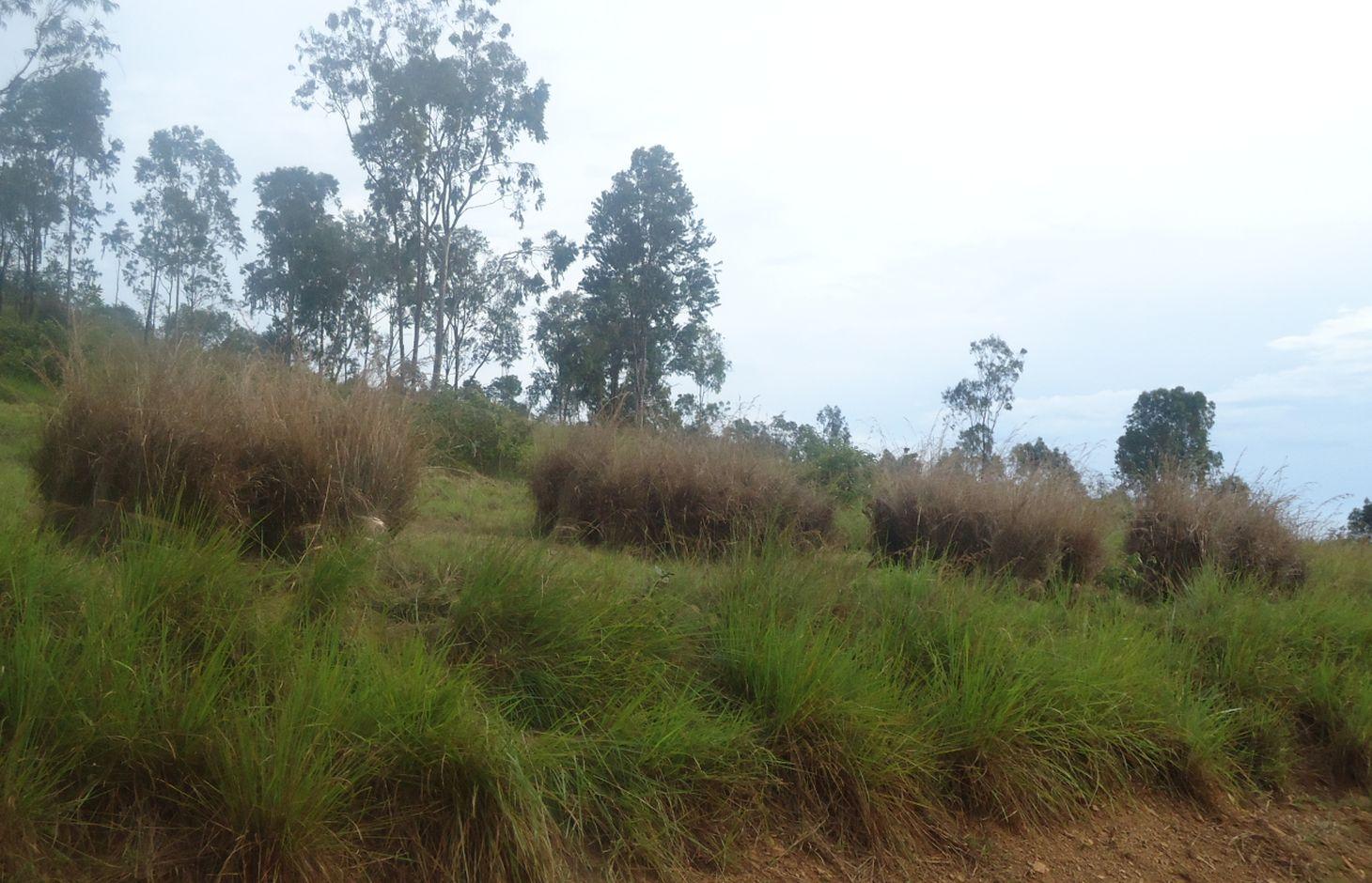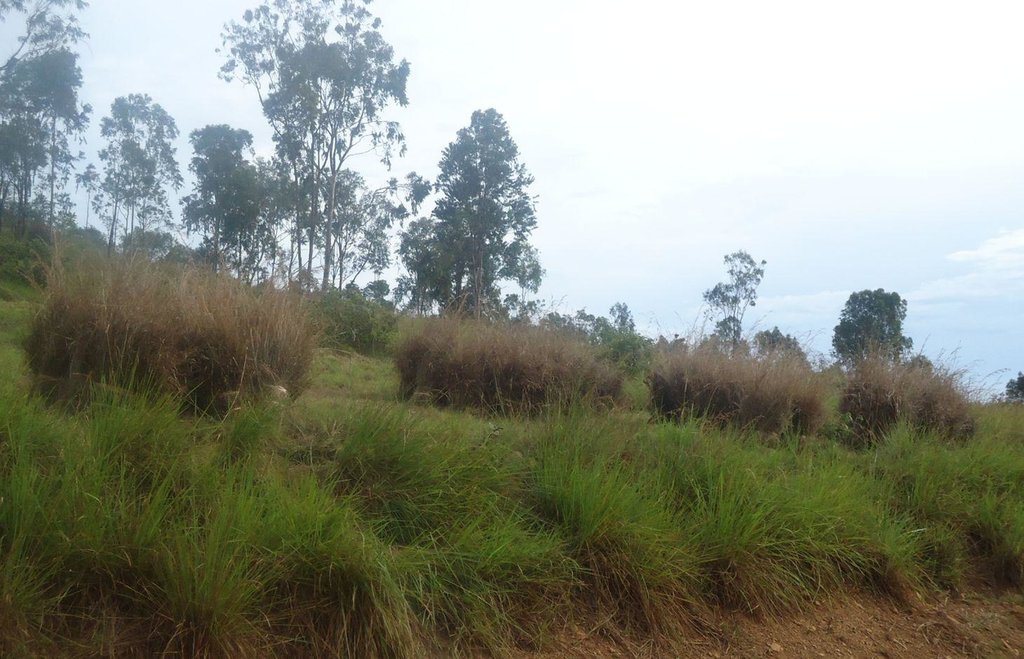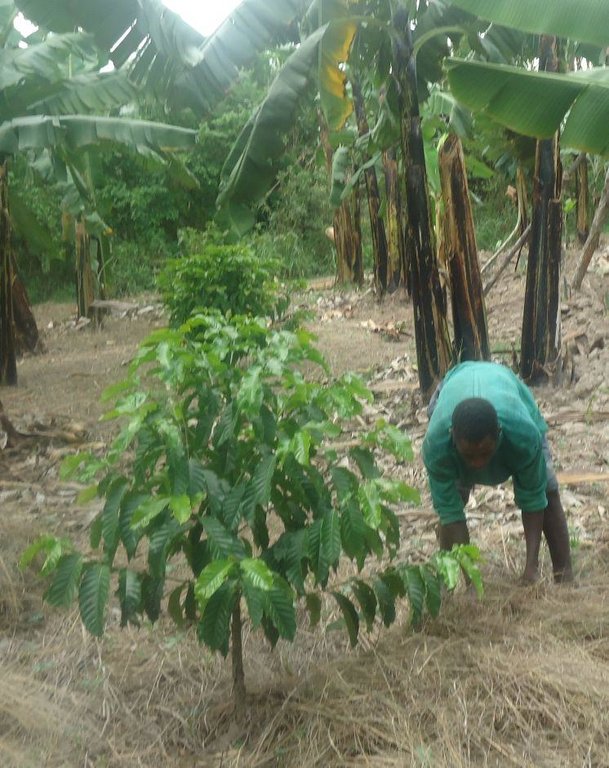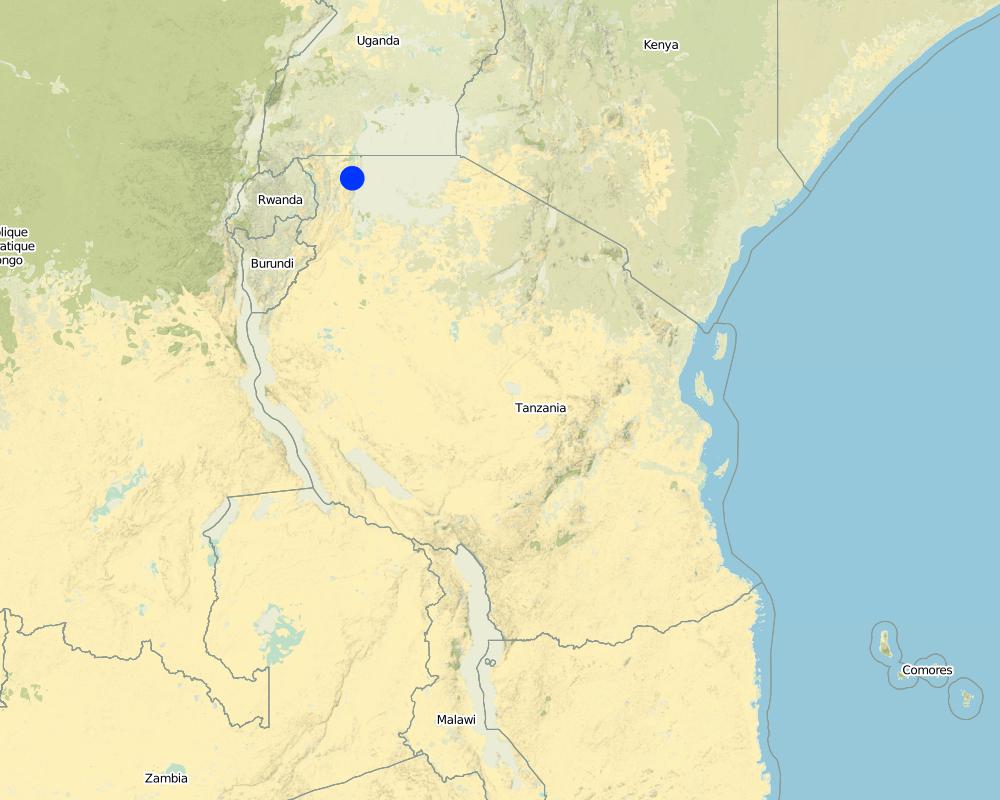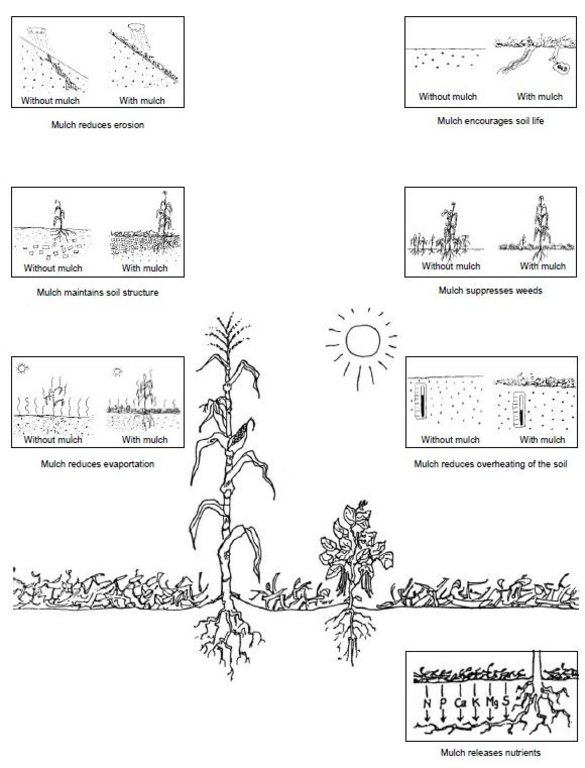Enhanced mulching in banana and coffee plantation [Tanzania, United Republic of]
- Creation:
- Update:
- Compiler: Iwona Piechowiak
- Editor: –
- Reviewers: David Streiff, Alexandra Gavilano
Okwalila ebinyasi omukibanja
technologies_1184 - Tanzania, United Republic of
View sections
Expand all Collapse all1. General information
1.2 Contact details of resource persons and institutions involved in the assessment and documentation of the Technology
Government:
Government:
Mashauri Babylus
Bukoba District Council
Tanzania, United Republic of
Government:
Rutatinisibwa Dominick
Bukoba District Council
Tanzania, United Republic of
Government:
Rwezahura Raphael
Bukoba District Council
Tanzania, United Republic of
SLM specialist:
Kaihura Fidelis
K-TAMP
Tanzania, United Republic of
Name of project which facilitated the documentation/ evaluation of the Technology (if relevant)
The Transboundary Agro-ecosystem Management Project for the Kagera River Basin (GEF-FAO / Kagera TAMP )Name of the institution(s) which facilitated the documentation/ evaluation of the Technology (if relevant)
FAO Food and Agriculture Organization (FAO Food and Agriculture Organization) - ItalyName of the institution(s) which facilitated the documentation/ evaluation of the Technology (if relevant)
Bukoba district council (Bukoba district council) - Tanzania, United Republic of1.3 Conditions regarding the use of data documented through WOCAT
The compiler and key resource person(s) accept the conditions regarding the use of data documented through WOCAT:
Yes
1.5 Reference to Questionnaire(s) on SLM Approaches (documented using WOCAT)
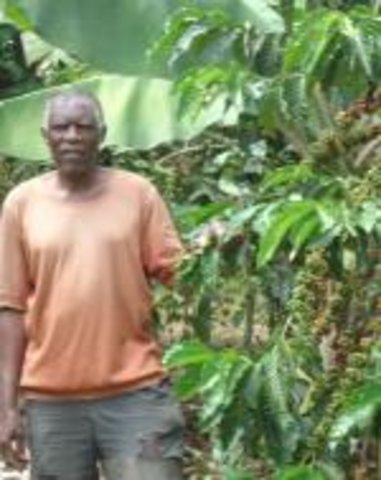
Indigenous knowledge transfer [Tanzania, United Republic of]
Indigenous knowledge transfer, is a common phenomena in farming societies whereby elders taught younger generations the practical aspects in production and emphasizes the norms and proms in folk story tales.
- Compiler: Godfrey Baraba
2. Description of the SLM Technology
2.1 Short description of the Technology
Definition of the Technology:
Application of Thatch and Hyperrhenia Rufa grass mulch in banana and coffee plantation to reduce soil erosion, improve soil fertility and moisture and ensure high productivity
2.2 Detailed description of the Technology
Description:
The technology is applied in coffee and banana fields in the sub humid climate. The technology objective is prevention of land degradation specifically nutrient improvement, erosion control, soil moisture and soil health (soil's living organisms) improvement. The materials applied are very variable perennial grass from 60-240 cm high. Panicle loose and narrow up to 50 cm long, with slightly spreading or contiguous racemes with shortly hairy or nearly glabrous spikelets 3.5-5 mm long. The materials are spreaded to 15cm thickness, manually across the slpoe, once per year, at the beginig of short rains.
Purpose of the Technology: The purpose of the technology is to retain moisture content in soil by promoting water infiltration during and after the rains, promoting water holding capacity through decay and formation of organic matter. Grass mulch control soil erosion by intercepting raindrops (splash erosion) that detach soil particles. Grass mulch technology improves soil nutrient through grass decomposition.
Establishment / maintenance activities and inputs: There is no establishment activities for the technology only maintenance activities (operational activities) are required once a year.
Maintenance activities include collection of mulching grasses -The grass is cut and collected by household or hired labor. The quantity of grass required per hectar is 1,500 cubic metre equivalent to 375 bundles.
To spread/apply mulching grasses -Grass is spread manually across the slope preferably to 15cm thickness. Dry grasses are spread across the slope with thickness of maximum 15cm. It is recommended to apply mulch grass around 15cm from the banana trunks.This is done once annually before the onset of short rains (during Augost and September)
Natural / human environment: The technology is applied on coffee/banaana fields. The Rainfall is 1000-1500mm, the subhumid climate (temp 26 -30 degree centigrade) and two growing seasons. The technology is meant for soil water evaporation contol and is tolerant in dry spell season while sensitive to excessive rains.
2.3 Photos of the Technology
2.5 Country/ region/ locations where the Technology has been applied and which are covered by this assessment
Country:
Tanzania, United Republic of
Region/ State/ Province:
Tanzania
Further specification of location:
Bukoba District (Karong village)
Specify the spread of the Technology:
- evenly spread over an area
If precise area is not known, indicate approximate area covered:
- 1-10 km2
Comments:
Only one farmstead considered
Map
×2.6 Date of implementation
If precise year is not known, indicate approximate date:
- more than 50 years ago (traditional)
2.7 Introduction of the Technology
Specify how the Technology was introduced:
- as part of a traditional system (> 50 years)
3. Classification of the SLM Technology
3.1 Main purpose(s) of the Technology
- reduce, prevent, restore land degradation
3.2 Current land use type(s) where the Technology is applied

Cropland
- Annual cropping
- Perennial (non-woody) cropping
- Tree and shrub cropping
Annual cropping - Specify crops:
- cereals - maize
- legumes and pulses - beans
- root/tuber crops - sweet potatoes, yams, taro/cocoyam, other
- root/tuber crops - cassava
Tree and shrub cropping - Specify crops:
- avocado
- coffee, open grown
- mango, mangosteen, guava
- Maesopsis
Number of growing seasons per year:
- 2
Specify:
Longest growing period in days: 120; Longest growing period from month to month: September (mid)- January (mid); Second longest growing period in days: 65; Second longest growing period from month to month: March-May
Comments:
Major land use problems (compiler’s opinion): Soil erosion, excessive soil water evaporation, fertility decline and reduced organic matter content
Major land use problems (land users’ perception): Excessive weed invasions and reduced productivity
3.4 Water supply
Water supply for the land on which the Technology is applied:
- rainfed
3.5 SLM group to which the Technology belongs
- improved ground/ vegetation cover
3.6 SLM measures comprising the Technology

agronomic measures
- A7: Others
Comments:
Specification of other agronomic measures: Grass mulching
Type of agronomic measures: mulching
3.7 Main types of land degradation addressed by the Technology

soil erosion by water
- Wt: loss of topsoil/ surface erosion

chemical soil deterioration
- Cn: fertility decline and reduced organic matter content (not caused by erosion)

biological degradation
- Bl: loss of soil life

water degradation
- Ha: aridification
Comments:
Secondary types of degradation addressed: Bl: loss of soil life
Main causes of degradation: soil management (Cultivation along the slope), Heavy / extreme rainfall (intensity/amounts), land tenure (few farmers own grassland), poverty / wealth (Peasants are not able to purchase grass mulch)
Secondary causes of degradation: crop management (annual, perennial, tree/shrub), disturbance of water cycle (infiltration / runoff) (Poor soil cover), droughts (There is soil water evaporation)
3.8 Prevention, reduction, or restoration of land degradation
Specify the goal of the Technology with regard to land degradation:
- prevent land degradation
- reduce land degradation
Comments:
Secondary goals: mitigation / reduction of land degradation
4. Technical specifications, implementation activities, inputs, and costs
4.1 Technical drawing of the Technology
Technical specifications (related to technical drawing):
What is the use of mulching?; Source: Müller-Sämann and Kotschi (1994)
Location: Karonge Village. Bukoba District Council
Date: 26 Feb 2014
Technical knowledge required for field staff / advisors: low
Technical knowledge required for land users: low
Main technical functions: control of raindrop splash, control of dispersed runoff: impede / retard, increase of infiltration, increase / maintain water stored in soil
Secondary technical functions: increase in organic matter, increase in nutrient availability (supply, recycling,…)
Mulching
Material/ species: Dried grasses (Thatch and Hyperrhenia Rufa grass )
Quantity/ density: 1500m3/ha
Remarks: Spreading across the slope
Author:
Godfrey Baraba, DED Bukoba District Council, Box 491, Bukoa.
4.2 General information regarding the calculation of inputs and costs
Specify currency used for cost calculations:
- USD
Indicate average wage cost of hired labour per day:
1.25
4.5 Maintenance/ recurrent activities
| Activity | Timing/ frequency | |
|---|---|---|
| 1. | Collection of mulching materials | May-June |
| 2. | Application of mulching materials (spreading) | June-August |
| 3. | Weeding | July and January |
| 4. | De trashing | February and September |
4.6 Costs and inputs needed for maintenance/ recurrent activities (per year)
| Specify input | Unit | Quantity | Costs per Unit | Total costs per input | % of costs borne by land users | |
|---|---|---|---|---|---|---|
| Labour | Collection and Apllication of mulching materials | persons/day/ha | 16.0 | 1.5625 | 25.0 | 100.0 |
| Construction material | Mulch | ha | 1.0 | 117.0 | 117.0 | 100.0 |
| Total costs for maintenance of the Technology | 142.0 | |||||
| Total costs for maintenance of the Technology in USD | 142.0 | |||||
Comments:
per hectar of land protected; cost of purchasing 375 bundles of grass and their spread to be $0.3 per bundle and 20 mandays at $ 1.2
4.7 Most important factors affecting the costs
Describe the most determinate factors affecting the costs:
Cost of purchasing mulch grass is the most determinate factor. Mostly due to long distance to fetch the grass and the scatered nature due to degradation and encroachment by tree planting.
5. Natural and human environment
5.1 Climate
Annual rainfall
- < 250 mm
- 251-500 mm
- 501-750 mm
- 751-1,000 mm
- 1,001-1,500 mm
- 1,501-2,000 mm
- 2,001-3,000 mm
- 3,001-4,000 mm
- > 4,000 mm
Specifications/ comments on rainfall:
Short rains Sept-November, long rains March-May,length of dry period 180 days
Agro-climatic zone
- sub-humid
Thermal climate class: tropics
5.2 Topography
Slopes on average:
- flat (0-2%)
- gentle (3-5%)
- moderate (6-10%)
- rolling (11-15%)
- hilly (16-30%)
- steep (31-60%)
- very steep (>60%)
Landforms:
- plateau/plains
- ridges
- mountain slopes
- hill slopes
- footslopes
- valley floors
Altitudinal zone:
- 0-100 m a.s.l.
- 101-500 m a.s.l.
- 501-1,000 m a.s.l.
- 1,001-1,500 m a.s.l.
- 1,501-2,000 m a.s.l.
- 2,001-2,500 m a.s.l.
- 2,501-3,000 m a.s.l.
- 3,001-4,000 m a.s.l.
- > 4,000 m a.s.l.
Indicate if the Technology is specifically applied in:
- convex situations
Comments and further specifications on topography:
Slopes on average: 6.25%
Altitudinal zone: 1194 m a.s.l.
5.3 Soils
Soil depth on average:
- very shallow (0-20 cm)
- shallow (21-50 cm)
- moderately deep (51-80 cm)
- deep (81-120 cm)
- very deep (> 120 cm)
Soil texture (topsoil):
- coarse/ light (sandy)
- fine/ heavy (clay)
Topsoil organic matter:
- medium (1-3%)
- low (<1%)
If available, attach full soil description or specify the available information, e.g. soil type, soil PH/ acidity, Cation Exchange Capacity, nitrogen, salinity etc.
Soil fertility is low - medium
Soil drainage / infiltration is medium
Soil water storage capacity is medium
5.4 Water availability and quality
Ground water table:
5-50 m
Availability of surface water:
medium
Water quality (untreated):
good drinking water
5.5 Biodiversity
Species diversity:
- medium
5.6 Characteristics of land users applying the Technology
Market orientation of production system:
- mixed (subsistence/ commercial)
Off-farm income:
- less than 10% of all income
Relative level of wealth:
- average
- rich
Individuals or groups:
- individual/ household
Level of mechanization:
- manual work
Gender:
- women
- men
Indicate other relevant characteristics of the land users:
Land users applying the Technology are mainly common / average land users
Difference in the involvement of women and men: De trashing commonly done by men, collection and application of mulch commonly done by women
Annual population growth: 0.5% - 1%
20% of the land users are rich and own 40% of the land.
80% of the land users are average wealthy and own 60% of the land.
Market orientation of production system: Coffee is purely for commercial while banana is for both subsistance and commercial
Level of mechanization: Cultivation is done at establishment phase, another farming systems limits mechanization
5.7 Average area of land used by land users applying the Technology
- < 0.5 ha
- 0.5-1 ha
- 1-2 ha
- 2-5 ha
- 5-15 ha
- 15-50 ha
- 50-100 ha
- 100-500 ha
- 500-1,000 ha
- 1,000-10,000 ha
- > 10,000 ha
Is this considered small-, medium- or large-scale (referring to local context)?
- small-scale
5.8 Land ownership, land use rights, and water use rights
Land ownership:
- communal/ village
- individual, not titled
Land use rights:
- communal (organized)
- individual
Water use rights:
- open access (unorganized)
- communal (organized)
Comments:
The technology is highly adopted by well to do farmers, either having off farm source of income or old farmer after achieving reasonable savings. This is because the communal range land has encroached by protected forest.
5.9 Access to services and infrastructure
health:
- poor
- moderate
- good
education:
- poor
- moderate
- good
technical assistance:
- poor
- moderate
- good
employment (e.g. off-farm):
- poor
- moderate
- good
markets:
- poor
- moderate
- good
energy:
- poor
- moderate
- good
roads and transport:
- poor
- moderate
- good
drinking water and sanitation:
- poor
- moderate
- good
financial services:
- poor
- moderate
- good
Church:
- poor
- moderate
- good
6. Impacts and concluding statements
6.1 On-site impacts the Technology has shown
Socio-economic impacts
Production
crop production
fodder quality
Comments/ specify:
Hyperrhamia rufa is un palatable, hence its dominance implies reduced fodder quality.
animal production
Comments/ specify:
Unpalatability of Hyperrhamia rufa implies reduced nutrient intake, hence animal production is reduced.
risk of production failure
Water availability and quality
demand for irrigation water
Income and costs
expenses on agricultural inputs
Quantity before SLM:
0
Quantity after SLM:
135
Comments/ specify:
Purchase of mulch grass, without transport and labor for spreading mulch.
workload
Socio-cultural impacts
food security/ self-sufficiency
Comments/ specify:
Increased banana productivity, labores earn income for purchasing food
SLM/ land degradation knowledge
Comments/ specify:
Practiced farmers respected as inovators as well as progressive farmers
situation of socially and economically disadvantaged groups
Quantity before SLM:
0 mandays
Quantity after SLM:
10 mandays
Comments/ specify:
Cutting mulching grasses are income generating activities for young men and women.
livelihood and human well-being
Comments/ specify:
Improved coffee/banana mulching increases farm income. Additional revenue is spent for child’s education and health services
Working in distant unconducive environment
Ecological impacts
Water cycle/ runoff
surface runoff
evaporation
Soil
soil moisture
soil compaction
soil organic matter/ below ground C
Biodiversity: vegetation, animals
beneficial species
Comments/ specify:
Soil's living organisms
6.2 Off-site impacts the Technology has shown
downstream siltation
damage on neighbours' fields
Comments/ specify:
Surface water run-off is combated in the area, hence neighbor's fields face only rain direct rain drops.
Nutrient transfer from grassland to crop land
6.3 Exposure and sensitivity of the Technology to gradual climate change and climate-related extremes/ disasters (as perceived by land users)
Gradual climate change
Gradual climate change
| Season | increase or decrease | How does the Technology cope with it? | |
|---|---|---|---|
| annual temperature | increase | well |
Climate-related extremes (disasters)
Meteorological disasters
| How does the Technology cope with it? | |
|---|---|
| local rainstorm | not well |
| local windstorm | well |
Climatological disasters
| How does the Technology cope with it? | |
|---|---|
| drought | well |
Other climate-related consequences
Other climate-related consequences
| How does the Technology cope with it? | |
|---|---|
| reduced growing period | well |
| not known |
6.4 Cost-benefit analysis
How do the benefits compare with the maintenance/ recurrent costs (from land users' perspective)?
Short-term returns:
slightly negative
Long-term returns:
positive
Comments:
No establishment costs, recurrent costs for mulching Technology for three years consecutively, can increase productivity in two folds and be maintained for more than ten years.
6.5 Adoption of the Technology
- > 50%
If available, quantify (no. of households and/ or area covered):
1766 households (68 percent of land users in stated area)
Of all those who have adopted the Technology, how many did so spontaneously, i.e. without receiving any material incentives/ payments?
- 91-100%
Comments:
1766 land user families have adopted the Technology without any external material support
Comments on spontaneous adoption: There are farmers who apply dried banana leaves and pseudo stem as mulch.
There is a moderate trend towards spontaneous adoption of the Technology
Comments on adoption trend: The adoption is moderate simply because of increasing cost of mulching grasses compared to produce farm gate price increase. Furthermore the labour force is dominated by the elderly.
6.7 Strengths/ advantages/ opportunities of the Technology
| Strengths/ advantages/ opportunities in the land user’s view |
|---|
|
Increase in soil moisture especially during the dry season How can they be sustained / enhanced? Perform regularly maintenance activities |
|
Reduced weeds How can they be sustained / enhanced? Apply mulch grasses at the depth of 15 cm twice a year for the first 3 years consecutively |
|
Fertility increase How can they be sustained / enhanced? Soft loan of livestock to be provided to farmers |
| Strengths/ advantages/ opportunities in the compiler’s or other key resource person’s view |
|---|
|
Esy to implement and maintain How can they be sustained / enhanced? Promote extended use of the technology (knowledge sharing) |
|
Multiple ecological benefits: improved soil organic matter, soil moisture and soil biodiversity How can they be sustained / enhanced? Educate farmers on diversified mulching materials and systems e.g. intercropping, cover crops, minimum tillage |
|
Prevent soil erosion How can they be sustained / enhanced? Combine other conservation technologies e.g. contour construction with mulching. |
6.8 Weaknesses/ disadvantages/ risks of the Technology and ways of overcoming them
| Weaknesses/ disadvantages/ risks in the land user’s view | How can they be overcome? |
|---|---|
| Does not stay longer, it can persist for one season, hence requires twice application | Apply the correct quality and quantity material. |
| Not readily available to all farmers simply because range land has been allocated to well to do farmers. |
Land tenure system and land use planning should be revisited |
| Increased manual labour (cutting, transportation spreading) | Plant grasses like vertiva |
| Weaknesses/ disadvantages/ risks in the compiler’s or other key resource person’s view | How can they be overcome? |
|---|---|
| Grass mulch available only to farmers with grassland | Other measures should be encouraged (use of chopped banana,pseudo stem, leaves and sheaths) |
| Degradation of grassland | Promotion of SLM Technologies for grassland conservation |
7. References and links
7.1 Methods/ sources of information
7.3 Links to relevant online information
Title/ description:
Kagera TAMP project website
URL:
http://www.fao.org/nr/kagera/en/
Links and modules
Expand all Collapse allLinks

Indigenous knowledge transfer [Tanzania, United Republic of]
Indigenous knowledge transfer, is a common phenomena in farming societies whereby elders taught younger generations the practical aspects in production and emphasizes the norms and proms in folk story tales.
- Compiler: Godfrey Baraba
Modules
No modules


